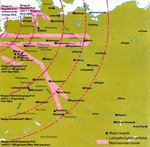- Thread starter
- #81
That is very interesting.
So it would seem the engines with the aux blowers (2-stage supercharging), and the planes powered by them, would have had high altitude advantages over engines and planes without aux blowers (single-stage supercharging.) And perhaps have the potential to participate in high altitude operations in ETO.
AFAIK, V-1710 did not have an aux blower and Merlin only installed a 2nd stage later on, although I don't think R/R called it an aux blower.
So it would seem the engines with the aux blowers (2-stage supercharging), and the planes powered by them, would have had high altitude advantages over engines and planes without aux blowers (single-stage supercharging.) And perhaps have the potential to participate in high altitude operations in ETO.
AFAIK, V-1710 did not have an aux blower and Merlin only installed a 2nd stage later on, although I don't think R/R called it an aux blower.

